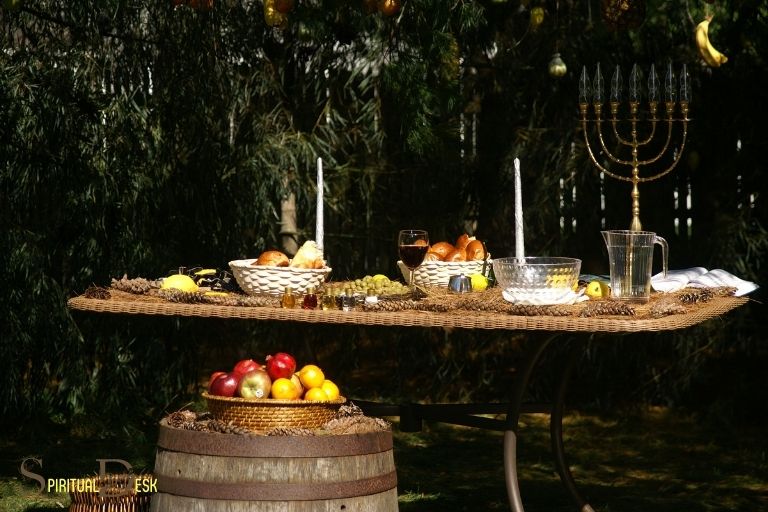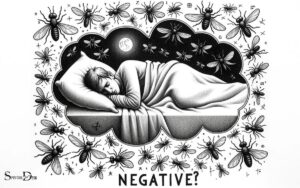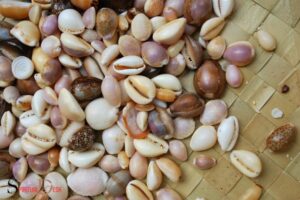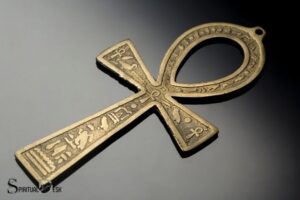What Is The Spiritual Meaning Of Sukkot? God’s Provision
The spiritual meaning of Sukkot is a celebration of God’s provision for the Israelites during their 40-year journey through the wilderness, following their liberation from slavery in Egypt.
It is also known as the Feast of Tabernacles, which symbolizes God’s protection and provision.
Sukkot is a biblical Jewish holiday celebrated in the seventh month, Tishrei, which typically falls in late September to late October. The spiritual observance involves dwelling in a temporary hut or booth known as a “sukkah” for seven days and nights.
This is done as a remembrance of the temporary dwellings the Israelites lived during their wilderness journey to the Promised Land.
The Sukkot holiday, often marked by eating meals in the sukkah and performing the wave ceremony with the ‘Four Species’ (etrog, lulav, hadass, and arava), serves as a time of reflection and gratitude.
It is a celebration of faith, reminding participants of God’s continuous care, protection, and provision for His people.
This spiritual significance continues to resonate with several people, strengthening their faith and deepening their understanding of God’s nature.
7 Aspects: Spiritual Meaning of Sukkot
| Aspects | Spiritual Meaning of Sukkot |
|---|---|
| General Definition | Sukkot is a weeklong Jewish festival that comes five days after Yom Kippur. It celebrates the gathering of the harvest and commemorates the miraculous protection God provided for the children of Israel when they left Egypt. |
| Symbol of Sukkah | The sukkah, a temporary hut constructed for use during the festival, represents God’s enveloping presence in our lives. |
| Four Species | The Four Species (etrog, lulav, hadass, and aravah) symbolize different types of individuals and their importance in the community. The combination of the four species is seen as a symbol of unity. |
| Divine Protection | The festival reminds the Jewish people of their absolute dependence on God’s protection, which was evident during their 40 years of wandering through the desert post-exile from Egypt. |
| Harvest Celebration | The gathering and blessing of the harvest symbolize God’s provision and bounty. It is a time of joy and thanksgiving to God for the abundance of blessings. |
| Temporary Dwellings | The temporary nature of the sukkah serves as a reminder of the transitory nature of our lives on Earth, with the spiritual realm being everlasting. |
| Spiritual Joy | Sukkot is also known as Z’man Simchateinu, the Season of our Rejoicing. It symbolizes a time of closeness with God, expressing joy and gratitude for the spiritual and material blessings He provides. |
Key Takeaway

Five Facts About: the Spiritual Meaning of Sukkot
Embracing Sukkot: Exploring The Essence Of The Festival
Sukkot, also known as the feast of tabernacles, is a joyous jewish festival that holds deep spiritual significance.
It is a time of reflection, connection, and gratitude, as well as an opportunity to delve into the historical roots of this sacred celebration.
In this section, we will uncover the historical origins of sukkot, explore our ancestors’ journey, and unveil the spiritual significance that resonates within this festival.
The Historical Origins Of Sukkot
Sukkot traces its roots back to the ancient israelites’ wandering in the desert for 40 years after their liberation from egypt. The festival serves as a commemoration of their nomadic existence during that period.
Here are the key points regarding the historical origins of sukkot:
- Living in temporary shelters: During their time in the desert, the israelites lived in temporary dwellings called sukkot. These sukkot were simple structures made of natural materials such as branches, leaves, and woven reeds.
- Symbolizing dependence on a higher power: By residing in these makeshift shelters, the israelites were reminded of their reliance on the divine providence and protection that sustained them throughout their journey.
- Connection to agricultural practices: Sukkot also coincided with the harvest season in ancient israel. It was a time of thanksgiving for the bountiful crops and an opportunity to acknowledge the blessings of nature and the cycle of life.
Connecting With Our Ancestors’ Journey
Sukkot invites us to connect with our ancestors’ journey and retrace their footsteps through the festival’s rituals and practices.
Here are the key points to consider when it comes to connecting with our ancestors’ journey:
- Building a sukkah: One of the central aspects of sukkot is the construction of a sukkah, a temporary dwelling representative of the sukkot of old. It symbolizes the humble abodes in which our ancestors lived and emphasizes the transient nature of life.
- Dining in the sukkah: Sharing meals in the sukkah allows us to experience the communal spirit that our ancestors enjoyed during their time in the desert. It fosters a sense of unity, gratitude, and appreciation for the blessings of nourishment and fellowship.
- Rejoicing with the lulav and etrog: Another tradition during sukkot is the waving of the lulav (a bundle of palm, willow, and myrtle branches) and etrog (a citron fruit). This ritual is a tangible connection to the agricultural roots of sukkot and a reminder of our connection to the land and the natural world.
Unveiling The Spiritual Significance
Beyond the historical and ancestral connections, sukkot carries profound spiritual meaning for those who celebrate it.
Here are the key points to unveil the spiritual significance of sukkot:
- Gratitude for the harvest of life: Sukkot encourages us to express gratitude for the abundant blessings in our lives. It serves as a reminder that just as we gather the bountiful harvest of nature, we must also acknowledge and appreciate the blessings and abundance present in our own lives.
- Embracing vulnerability and impermanence: The sukkah symbolizes vulnerability and reminds us of the fleeting nature of worldly possessions and comfort. It encourages us to embrace impermanence and to find strength and meaning in the transient aspects of life.
- Seeking spiritual shelter: The sukkah is considered a spiritual shelter, offering us an opportunity to connect with the divine and find solace in its presence. It is a space where we can reflect, meditate, and deepen our spiritual connection.
As we embrace sukkot, we not only honor our ancestors and their journey but also embark on our own spiritual exploration. This festival invites us to express gratitude, foster connection, and seek meaning in the transient nature of life.
By engaging in the rituals and reflecting on the spiritual significance, we can find inspiration and growth during this sacred time.
The Symbolism Of Sukkot: Dwelling In Divine Presence
Sukkot, also known as the feast of tabernacles, is a joyous festival celebrated by jewish people around the world. Its spiritual significance goes beyond the simple act of dwelling in temporary shelters.
Let’s explore the symbolism of sukkot and how it represents the idea of dwelling in the divine presence.
The Sukkah As A Temporary Shelter
- The sukkah is a temporary shelter constructed during sukkot and represents the impermanence of life on earth.
- It reminds us of the israelites’ journey through the desert after their liberation from slavery in egypt, where they lived in temporary structures.
- Just as the israelites relied on divine guidance and protection during their journey, the sukkah serves as a reminder of our dependence on a higher power.
The Sukkah’S Symbolic Representation
- The sukkah represents the divine presence of god, also known as the shekhinah.
- By entering the sukkah, individuals are symbolically entering into god’s presence and experiencing a spiritual connection.
- The open-roof design of the sukkah allows for a view of the sky, connecting worshippers to the greater universe and the expansive nature of the divine.
Cultivating Humility And Appreciation In The Sukkah
- The temporary and humble nature of the sukkah encourages individuals to cultivate humility and gratitude.
- In the sukkah, people are reminded of the fragility of life and the importance of cherishing each moment.
- It serves as a powerful reminder to appreciate the blessings we have and not to take them for granted.
Sukkot holds deep spiritual meaning, transcending its physical aspects. Through the symbolism of the sukkah, we are invited to dwell in the divine presence, cultivate humility, and appreciate the blessings that surround us.
Embracing the lessons of sukkot can lead to a greater sense of gratitude and connectedness to the divine.
Celebrating Nature’S Bounty: Sukkot And Harvest Season
Sukkot, also known as the feast of tabernacles, is a joyous jewish holiday that holds deep spiritual significance.
It is celebrated in autumn, around the same time as harvest season, and is a time for expressing gratitude for the abundance of nature and connecting with the environment.
Let’s explore the role of sukkot in the agricultural calendar, the act of expressing gratitude for the harvest, and the importance of connecting with nature and the environment during this festive time.
The Role Of Sukkot In The Agricultural Calendar
Sukkot holds a central position in the agricultural calendar, marking the culmination of the harvest season.
As farmers gather their crops and prepare for the winter months ahead, this holiday serves as a time to honor and appreciate the fruits of their labor.
It symbolizes the transition from the hard work of farming to the celebration of the earth’s gifts.
Here’s what you need to know:
- Celebrated in autumn as a way to acknowledge the end of the harvest season.
- Farmers rejoice and express gratitude for the abundance of their crops.
- The timing reflects the agricultural cycle and the importance of sustenance.
Expressing Gratitude For The Harvest
Gratitude is an integral part of sukkot, and expressing appreciation for the harvest is a central theme of this holiday. It provides an opportunity to acknowledge and give thanks for the blessings bestowed upon us by nature and the earth’s resources.
Here’s how gratitude is expressed during sukkot:
- Building a sukkah, a temporary outdoor structure, represents the simplicity and impermanence of life.
- Sharing meals with family and friends in the sukkah fosters a sense of community and gratitude.
- The four species, consisting of a palm branch, citrus fruit, willow, and myrtle, are held together and waved as an expression of gratitude.
Connecting With Nature And The Environment During Sukkot
Sukkot is not just a time for celebrating the harvest; it also serves as a reminder of our connection with the natural world and the environment.
It calls upon us to appreciate and protect our surroundings, promoting ecological consciousness and responsibility.
Here’s how sukkot fosters a deeper connection with nature:
- Spending time in the sukkah, decorated with natural elements such as branches and fruits, allows us to immerse ourselves in nature’s beauty.
- The temporality of the sukkah reminds us of our dependence on the earth’s resources and the need for sustainable practices.
- The act of waving the four species connects us symbolically with the elements of nature and recognizes our interdependence with the environment.
Sukkot, with its focus on celebrating nature’s bounty, expressing gratitude for the harvest, and fostering a connection with the environment, reminds us of the importance of embracing and caring for the world around us.
It encourages us to live in harmony with nature, appreciating the abundance it provides and creating a sustainable future for generations to come.
So, join in the festivities of sukkot, immerse yourself in the beauty of the sukkah, and let the spirit of gratitude and environmental consciousness guide your celebrations.
The Spiritual Lessons Of Sukkot: Lessons In Faith And Trust
Sukkot, also known as the feast of tabernacles, is a joyous festival celebrated by jewish people around the world. It holds deep spiritual significance and provides valuable lessons in faith and trust.
Let’s explore the spiritual lessons of sukkot and how they can enrich our lives.
Trusting In Divine Providence
- The sukkah: At the heart of sukkot is the sukkah, a temporary structure representing the dwellings used by the israelites during their journey in the desert. The sukkah teaches us to rely on divine providence and trust in god’s protection, even in challenging circumstances.
- Leaving our comfort zones: Sukkot encourages us to step out of our comfort zones and embrace the unknown. By temporarily leaving our secure homes and dwelling in the sukkah, we learn to rely less on material possessions and more on our faith in god.
- Embracing vulnerability: The sukkah’s walls, made of temporary materials, remind us of the fragility of life. They teach us that true security lies not in physical structures but in our trust in god. By embracing vulnerability and surrendering control, we deepen our faith and develop a closer connection with the divine.
Embracing Impermanence And Change
Symbolic fruits: Sukkot is a harvest festival, and it is customary to decorate the sukkah with symbolic fruits and plants, such as apples, pomegranates, and palm branches.
These symbols remind us of the ever-changing seasons and the impermanence of life. They encourage us to embrace change and appreciate the beauty in the transitions we experience.
Letting go of attachments: Sukkot teaches us to detach ourselves from material possessions and the pursuit of wealth and success.
As we dwell in the sukkah, which lacks the comforts of our homes, we are reminded that true fulfillment comes from within, not from external circumstances. By letting go of attachments, we cultivate a sense of inner peace and contentment.
Embracing simplicity: Living in the sukkah for a week allows us to simplify our lives and focus on what truly matters.
It is a time to disconnect from the distractions of the modern world and reconnect with ourselves, our loved ones, and our spirituality.
Sukkot reminds us that simplicity can bring us profound joy and appreciation for the present moment.
Strengthening Our Relationship With God
Prayers and reflections: Sukkot provides an opportunity for introspection, prayer, and spiritual connection.
The festival includes special blessings and prayers, expressing gratitude for the harvest and seeking blessings for the year ahead. Through these practices, we deepen our relationship with god and foster a grateful heart.
Celebrating unity: Sukkot is also a time of unity and community. People come together to celebrate, share meals in the sukkah, and welcome guests.
This emphasis on communal harmony reminds us of the importance of love, compassion, and kindness in our spiritual journey.
Rejoicing in god’s presence: Sukkot is known as the “season of our joy” because it is a time of great celebration.
By rejoicing and finding joy in god’s presence, we uplift our spirits and strengthen our connection to the divine.
Sukkot offers profound spiritual lessons that resonate beyond its observance in judaism.
Through trusting in divine providence, embracing impermanence and change, and strengthening our relationship with god, this festival encourages us to cultivate faith, deepen our connections, and find meaning in the transient nature of life.
May these spiritual lessons of sukkot inspire us to live with greater faith, trust, and gratitude each day.
Sukkot And Unity: Coming Together As A Community
Sukkot As A Festival Of Unity
Sukkot, also known as the feast of tabernacles, holds great spiritual significance for those who celebrate it.
This joyous festival not only commemorates the israelites’ journey through the wilderness but also symbolizes unity and togetherness within the community.
Let’s explore how sukkot fosters a sense of unity among its participants.
- Sukkot brings people together: During sukkot, families and friends gather in temporary outdoor structures called sukkahs. This act of congregating in communal spaces promotes a sense of togetherness and unity within the community.
- A shared experience: By celebrating sukkot together, participants create a shared experience that strengthens communal bonds. Through this festival, individuals forge connections and cultivate a sense of belonging to a larger community.
- Equality and inclusivity: Sukkot emphasizes equality by encouraging everyone, regardless of their social status, to eat, sleep, and spend time in the sukkah. This practice reinforces the values of inclusivity and unity within the community.
Gathering In The Sukkah: Sharing Joy And Togetherness
The sukkah serves as the central symbol of sukkot, where families and friends come together to share meals and festivities. Let’s delve into how this gathering fosters joy and togetherness among participants.
- Enjoying meals in the sukkah: Sharing meals in the sukkah is a key tradition of sukkot. This act creates an atmosphere of joy and celebration as people come together to enjoy delicious food and engage in meaningful conversations.
- Spending time in nature: The sukkah, being a temporary structure with a roof made of natural materials, allows individuals to connect with nature. This connection fosters a sense of unity with the environment and adds to the overall experience of togetherness.
- Building bonds: Gathering in the sukkah provides an opportunity for families, friends, and even strangers to come together, strengthening existing relationships and building new ones. The act of sharing space in the sukkah encourages open conversations, laughter, and a deep sense of connection.
Fostering Community Spirit And Solidarity Through Sukkot
Sukkot plays a vital role in fostering community spirit and solidarity among its participants. Let’s explore how this festival encourages individuals to come together and support one another.
- Sharing resources: Sukkot encourages individuals to share food, hospitality, and resources with others. By doing so, participants develop a sense of empathy and compassion, nurturing a community spirit centered around supporting one another.
- Acts of kindness: During sukkot, people often perform acts of kindness, such as inviting others to their sukkah or providing meals for those in need. These acts foster a sense of solidarity and highlight the importance of coming together as a community to support one another.
- Engaging in communal activities: Sukkot offers various communal activities, such as parades, singing, and dancing, that bring people together. These shared experiences cultivate a sense of belonging and unity within the community.
Sukkot is not just a festival; it is an embodiment of unity, joy, and togetherness. Through the gathering in the sukkah, participants experience the joy of sharing meals, build deeper connections, and foster community spirit.
This celebration serves as a reminder of the power of unity and the importance of supporting one another in the journey of life.
So, let us come together during sukkot and embrace the spirit of unity that this sacred festival brings.
FAQ About What Is The Spiritual Meaning Of Sukkot?
What Is The Spiritual Significance Of Sukkot?
Sukkot is a jewish holiday that commemorates the time when the israelites lived in temporary shelters during their journey in the desert.
How Do People Celebrate Sukkot?
During sukkot, people build and decorate temporary outdoor structures called sukkahs, where they eat meals and often invite guests to join them.
Why Do People Shake The Lulav And Etrog On Sukkot?
The lulav and etrog are symbolic items that are shaken together during sukkot, representing unity and gratitude for the harvest.
Is Sukkot A Time For Reflection And Gratitude?
Yes, sukkot is a time for introspection and expressing gratitude for the bountiful harvest and the shelter provided by god.
Are There Any Special Foods Associated With Sukkot?
During sukkot, it is customary to eat meals inside the sukkah and enjoy seasonal and harvested foods, such as fruits and vegetables.
Conclusion
Sukkot, also known as the feast of tabernacles, is a vibrant jewish holiday with deep spiritual significance. It is a time of gratitude, celebration, and reflection, reminding us of the importance of connecting with nature, our fellow human beings, and the divine.
The construction of the sukkah, a temporary dwelling, symbolizes our reliance on god and our awareness of the transience of material possessions.
Throughout the week-long observance, we are reminded to appreciate the abundance in our lives and share our blessings with others.
Sukkot teaches us the value of hospitality, unity, and the joy that comes from embracing the present moment.
As we gather under the sukkah’s roof, surrounded by nature, family, and friends, we are reminded of the interconnectedness of all beings and the sacredness of life.
May the spiritual messages of sukkot inspire us to cultivate gratitude, compassion, and community in our everyday lives.
Bonus: What Is The Spiritual Meaning Of Sukkot?
What Is The Biblical Meaning Of Sukkot?
The biblical meaning of Sukkot is “Feast of Tabernacles.” This seven-day festival commemorates the 40 years that the Israelites wandered in the desert after their Exodus from Egypt. During this time, they lived in temporary dwellings called sukkot.
On the first day of Sukkot, Jews build sukkot (booths) and decorate them with fruits, vegetables, and branches to remember the time when their ancestors wandered in the wilderness.
Sukkot is also known as the “Season of Our Rejoicing” because it falls during harvest time. Jews celebrate by eating meals inside their sukkot and inviting friends and family to join them.
At night, they often sing songs and tell stories around a campfire. Some people even sleep overnight in their sukkot! On the seventh day of Sukkot, there is a special holiday called Hoshana Rabbah.
On this day, Jews march around the synagogue seven times while carrying willow branches and chanting prayers. This symbolizes their hope for a good harvest in the coming year.
What is The Symbolism of The Sukkah?
The sukkah is a symbol of the Jewish faith and heritage. It is a reminder of the time when the Jews were forced to live in temporary shelters during their Exodus from Egypt.
The sukkah also represents the fragility of human life and our dependence on God for protection and guidance.
What Do The Four Species Of Sukkot Represent?
Sukkot is a Jewish holiday that celebrates the harvest and features the construction of temporary huts or sukkahs. The four species used during Sukkot are known as the Four Species of Sukkot, and each represents a different aspect of the holiday.
- The first species is the etrog or Citrus medical. The etrog is a citrus fruit that is native to Israel and has been used in Judaism for ritual purposes since ancient times. The etrog symbolizes both the bounty of the harvest and the beauty of nature.
- The second species is the lulav or date palm frond. The lulav represents strength and stability, as well as fertility and new life.
- The third species is the myrtle or wilted leafy branch. The myrtle symbolizes both mournful occasions (such as funerals) and joyous ones (such as weddings). It also represents growth and regeneration.
- Finally, the fourth species is the willow or weeping fig tree branch. The willow reminds us of our own fragility and mortality, but also of hope and resilience in the face of adversity.
What Are The Signs And Symbols Of Sukkot?
Sukkot is a Jewish holiday that commemorates the 40-year period during which the Israelites wandered in the desert after their Exodus from Egypt.
Sukkot is also known as the Feast of Tabernacles or Festival of Shelters. During this holiday, Jews build sukkahs, temporary huts made of branches and leaves, to live in for seven days.
The holiday culminates on Simchat Torah when Jews joyfully celebrate the completion of the yearly cycle of reading the Torah.
There are several signs and symbols associated with Sukkot. One is the lulav, a bundle of palm fronds, myrtle branches, and willow twigs that is held together with an etrog (a citrus fruit).
The lulav is shaken in six directions each day during prayers. Another sign of Sukkot is the Etrog box, in which etrogs are stored and protected during the holiday.
This box usually has four sides and a lid decorated with images related to Sukkot or Judaism in general.
Another key symbol of Sukkot is the sukkah itself. As mentioned earlier, sukkahs are temporary huts built for Dwelling in during the week-long festival. They typically have three walls and a roof made of natural materials such as branches and leaves.
Some people decorate their sukkahs with lights, plants, or other festive decorations. Others keep it simple, using only what’s necessary to create a basic shelter.
Sukkot is a joyful holiday that celebrates both God’s faithfulness to his people and their own deliverance from slavery.
By living in temporary shelters and shaking palm fronds in six directions each day, Jews remember how precarious life can be and give thanks for all they have been given.
Sukkot Meaning
Sukkot is one of the most important holidays in the Jewish year. It is a time for rejoicing and celebrating, and it has a deep meaning and symbolism.
The word Sukkot means “booths” or “huts,” and refers to the temporary dwellings that the Israelites built during their 40 years in the desert.
On Sukkot, Jews build temporary sukkahs – often out of simple materials like wood and palm fronds – to remind us of those humble beginnings.
Sukkot also commemorates the harvest season. In ancient times, Jews would bring their harvested crops into the sukkah to thank God for His bounty.
Today, we celebrate by eating meals in our sukkahs and decorating them with fruits and vegetables.
But beyond all of these things, Sukkot is a holiday that celebrates life itself. It is a time to be thankful for all that we have – our families, our homes, our health, and all of God’s blessings.
Sukkot Symbols
Sukkot, also known as the Feast of Tabernacles or the Festival of Shelters, is one of the most important Jewish holidays. It celebrates the harvest and commemorates the time when the Israelites lived in temporary shelters during their 40 years in the desert.
Sukkot is a seven-day holiday that begins on Tishrei 15 (usually in September or October) and ends on Tishrei 21.
| ? One of the most recognizable symbols of Sukkot is the sukkah, a temporary hut built for the holiday. The sukkah must be large enough to fit a minimum of three people, have at least three walls (with one wall being at least partially open to allow for ventilation), and be covered with a roof made of natural materials such as branches or palm fronds. | ? Other items traditionally placed inside a sukkah include a table and chairs, decorations, and a special lamp called an etrog light. | ? Another common symbol associated with Sukkot is the lulav and etrog set. The lulav is a bundle of branches from four different types of trees: willow, myrtle, and palm. The etrog is a citrus fruit that resembles a lemon or lime. |
This ritual serves as both a reminder of God�s provision during times of scarcity and His role as Creator who brings forth life-giving water from dry land.
All told, Sukkot is rich with meaning and tradition � making it one of the most joyful and significant holidays on the Jewish calendar!
Why Is Sukkot Celebrated
Sukkot is a Jewish holiday that lasts for seven days and commemorates the harvest season. Jews build temporary shelters called sukkahs and live in them during this time to remember how their ancestors lived in the desert for 40 years after escaping from slavery in Egypt.
Sukkot Traditions
Sukkot is a Jewish holiday that celebrates the harvest and reminds us of the time when the Israelites wandered in the desert for 40 years.
The holiday lasts for seven days, during which time Jews build temporary shelters called sukkahs and eat all their meals inside them.
On the first night of Sukkot, we wave an etrog (a citrus fruit) and lulav (a palm frond) in six directions to symbolize God’s protection from all sides.
We also say special prayers and recite blessings over these objects. On each day of Sukkot, we perform a different mitzvah (good deed) such as giving charity, visiting the sick, or hosting guests in our sukkah. One of the most important parts of Sukkot is celebrating with family and friends.
We often have large meals together and share stories and laughs. By celebrating Sukkot, we not only remember our history but also reaffirm our commitment to living a good life according to God’s laws.
How Long Is Sukkot
Sukkot is one of the Jewish holidays that lasts for seven days. The holiday commemorates the time when the Jews lived in temporary shelters during their 40 years of wandering in the desert.
On Sukkot, Jews build sukkahs, which are temporary dwellings covered with branches and leaves, and eat all their meals inside them.
Sukkot begins on the 15th day of Tishrei, which is five days after Yom Kippur. It is a time of joy and celebration, and many people decorate their sukkahs with lights and flowers.
During Sukkot, Jews also wave the lulav and etrog, which are a palm branch and a citrus fruit respectively.
Jewish Holy Week
It’s Jewish Holy Week, which means it’s time to reflect on the past year and prepare for the new one. This week is also known as Pesach or Passover, and it commemorates the Exodus from Egypt.
Jews all over the world will celebrate by eating matzah (unleavened bread) and drinking wine and telling the story of how their ancestors were freed from slavery.
Sukkot 2022
Sukkot is a Jewish holiday that falls on the 15th day of the month of Tishrei. It is also known as the Feast of Tabernacles or the Festival of Ingathering.
Sukkot commemorates the 40 years that the Israelites spent wandering in the desert after they were freed from slavery in Egypt.
During this time, they lived in temporary shelters called sukkot. Today, Jews celebrate Sukkot by building their own sukkot and spending time in them. They also decorate them with fruits and vegetables to symbolize the bounty of the harvest season.
On each night of Sukkot, Jews recite prayers and blessings over wine and bread.






